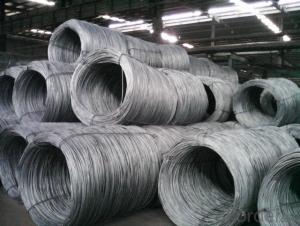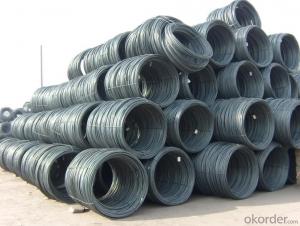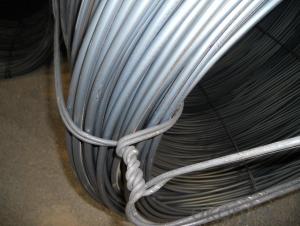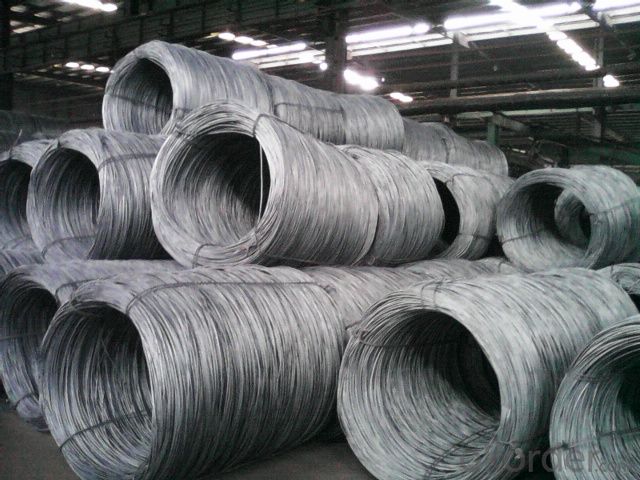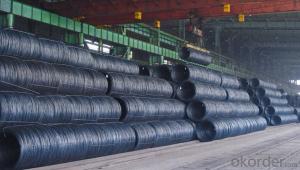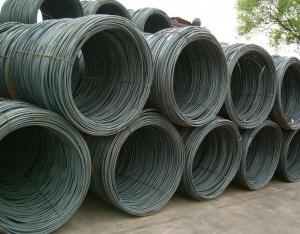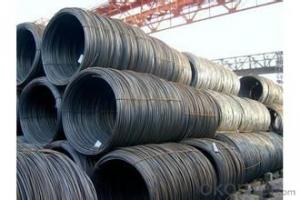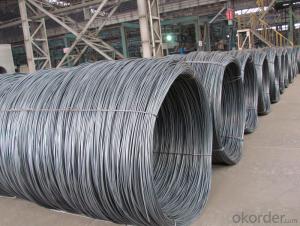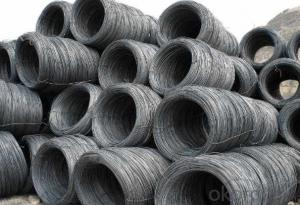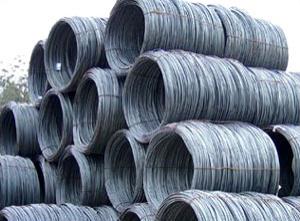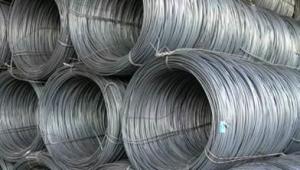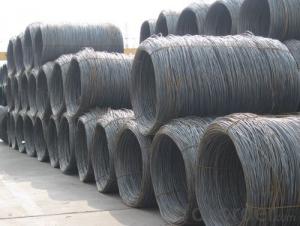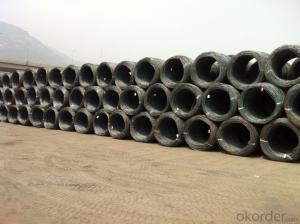Steel Wire Rod of Alloy Low Carbon Steel
- Loading Port:
- China main port
- Payment Terms:
- TT or LC
- Min Order Qty:
- 100 m.t.
- Supply Capability:
- 10000 m.t./month
OKorder Service Pledge
OKorder Financial Service
You Might Also Like
Specification
OKorder is offering Steel Wire Rod of Alloy Low Carbon Steel at great prices with worldwide shipping. Our supplier is a world-class manufacturer of steel, with our products utilized the world over. OKorder annually supplies products to African, South American and Asian markets. We provide quotations within 24 hours of receiving an inquiry and guarantee competitive prices.
Product Applications:
Steel Wire Rod of Alloy Low Carbon Steel are ideal for structural applications and are widely used in reinforcement of reinforced concrete and welded structure or reprocessed (roberts , nail, etc.) materials, especially used to produce wire drawing, welding electrode, nails, spring, electronic, precise machinery parts and so on.
Product Advantages:
OKorder's Steel Wire Rod of Alloy Low Carbon Steel are durable, strong, and wide variety of sizes.
Main Product Features:
· Premium quality
· Prompt delivery & seaworthy packing (30 days after receiving deposit)
· Can be recycled and reused
· Mill test certification
· Professional Service
· Competitive pricing
Product Specifications:
Steel Grade: Q195/235, SAE1006-1018B
Standard: ASTM, GB
Diameter: 5.5mm, 6.5mm, 7mm,8mm,9mm,10mm,12mm,14mm
Type: in coil, coil weight around 2MT
Alloy or Not: Alloy
Technique: Hot Rolled
Place of Origin: China Mainland
Surface: round, no twisted, light and smooth
Grade | Chemical Composition(%) | |||||
C | Mn | Si | S | P | B | |
SAE1006B | 0.03~O.07 | ≤0.32 | ≤0.30 | ≤0.045 | ≤0.040 | >0.0008 |
Mechanical properties | ||||||
Yield strength(N/mm2) | Tensile strength(N/mm2) | Elongation(%) | ||||
250-280 | 350-380 | ≥32 | ||||
Grade | Chemical Composition(%) | |||||
C | Mn | Si | S | P | B | |
SAE1008B | 0.10max | 0.3~O.50 | 0.15max | 0.050max | 0.040 max | 0.0008 min |
Mechanical properties | ||||||
Yield strength(N/mm2) | Tensile strength(N/mm2) | Elongation(%) | ||||
≥195 | 315-430 | ≥30 | ||||
Grade | Chemical Composition(%) | |||||
C | Mn | Si | S | P | B | |
Q195B | 0.06~O.12 | 0.25~O.50 | ≤0.30 | ≤0.050 | ≤0.045 | >0.0008 |
Mechanical properties | ||||||
Yield strength(N/mm2) | Tensile strength(N/mm2) | Elongation(%) | ||||
≥195 | 315-430 | ≥33 | ||||
Grade | Chemical Composition(%) | |||||
C | Mn | Si | S | P | B | |
Q235B | 0.12~O.2 | 0.3~O.701 | ≤0.30 | ≤0.045 | ≤0.045 | >0.0008 |
Mechanical properties | ||||||
Yield strength(N/mm2) | Tensile strength(N/mm2) | Elongation(%) | ||||
235 | 375-500 | ≥26 | ||||
FAQ:
Q1: Why buy Materials & Equipment from OKorder.com?
A1: All products offered byOKorder.com are carefully selected from China's most reliable manufacturing enterprises. Through its ISO certifications, OKorder.com adheres to the highest standards and a commitment to supply chain safety and customer satisfaction.
Q2: How do we guarantee the quality of our products?
A2: We have established an advanced quality management system which conducts strict quality tests at every step, from raw materials to the final product. At the same time, we provide extensive follow-up service assurances as required.
Q3: How many tons of steel products could be loaded in containers?
A3: Usually the steel products are delivered by bulk vessel because of the large quantity and the freight. However, there are no bulk vessel enter some seaports so that we have to deliver the cargo by containers. The 6m steel product can be loaded in 20FT container, but the quantity is changed according to the size, usually from 18tons to 25tons.
Images:
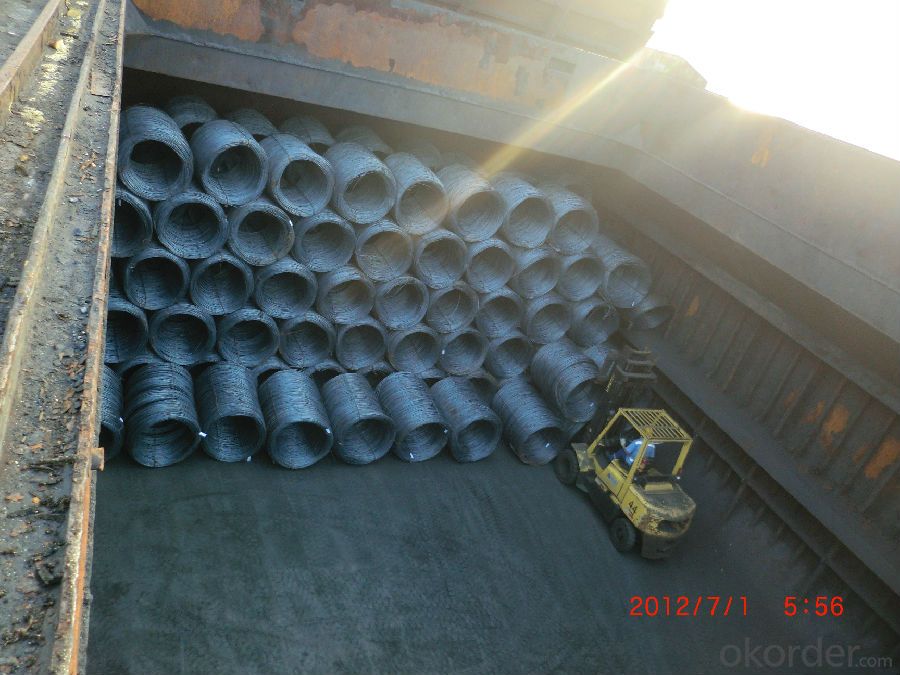
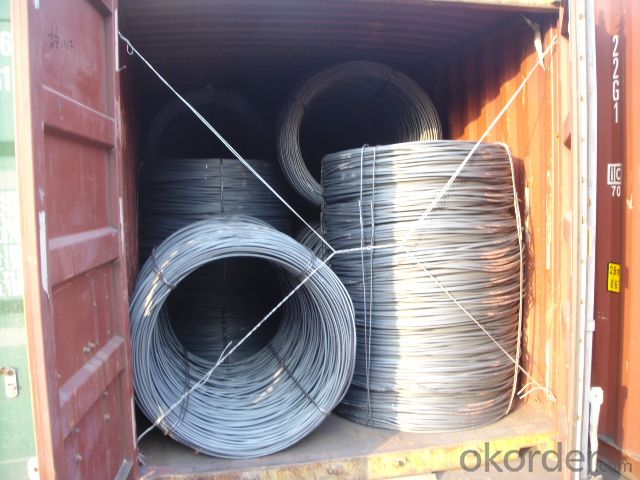
- Q: What are the different heat treatments applied to steel wire rod?
- There are several heat treatments commonly applied to steel wire rod, including annealing, quenching and tempering, normalization, and stress relieving.
- Q: What are the typical dimensions of steel wire rod?
- The typical dimensions of steel wire rod vary depending on the specific application and industry requirements. However, common dimensions range from 5.5mm to 14mm in diameter.
- Q: How is steel wire rod used in the production of cold-formed steel sections?
- Steel wire rod is used in the production of cold-formed steel sections as it serves as the primary raw material. The wire rod is first drawn through a series of dies to reduce its diameter and increase its length. This process strengthens the wire, making it more suitable for forming into various shapes and profiles. The cold-formed steel sections are then manufactured by bending, folding, or rolling the wire rod into the desired shapes, such as beams, channels, or angles. The high strength and versatility of steel wire rod make it an essential component in the production of cold-formed steel sections.
- Q: How is steel wire rod used in the manufacturing of wire ties for construction sites?
- Steel wire rod is an essential component in the manufacturing of wire ties for construction sites. These wire ties are widely used in the construction industry for various purposes, such as securing rebar, reinforcing concrete structures, and fastening construction materials together. The steel wire rod serves as the raw material for producing wire ties. It undergoes a series of processes to transform it into the final product. First, the wire rod is cleaned and coated to enhance its corrosion resistance. This coating, often made of zinc, provides an added layer of protection against rust and ensures the wire tie's longevity in harsh construction environments. Next, the coated steel wire rod is fed into a wire drawing machine where it is pulled through a die to reduce its diameter to the desired size. This process is repeated several times to achieve the required wire thickness and strength. Once the wire is drawn to the desired gauge, it is then cut into appropriate lengths to produce individual wire ties. These lengths can vary depending on the specific application and requirements of the construction project. The wire is then bent, twisted, or formed into the shape of a tie using specialized machinery. Wire ties made from steel wire rod offer exceptional strength, durability, and flexibility. They can be easily bent or twisted to fit around various construction materials, ensuring a secure and tight connection. Moreover, the high tensile strength of steel wire rod ensures that the wire ties can withstand considerable stress and load without breaking or deforming. The wire ties manufactured from steel wire rod are commonly used in construction sites to secure and fasten rebar during concrete pouring. They are also used to reinforce concrete structures, such as walls, columns, and beams. Additionally, wire ties are employed to bundle or tie together construction materials, including pipes, cables, and electrical wires, ensuring proper organization and preventing potential hazards. In summary, steel wire rod plays a crucial role in the manufacturing of wire ties for construction sites. These wire ties provide essential support and reinforcement in various construction applications, offering durability, flexibility, and strength to ensure the safety and stability of construction projects.
- Q: What are the standard straightness requirements for steel wire rod?
- The standard straightness requirements for steel wire rod are typically specified by industry standards or customer specifications. These requirements ensure that the wire rod has a straight and uniform shape, which is crucial for its intended applications. One common straightness requirement for steel wire rod is the maximum allowable deviation from a straight line. This is usually specified as a maximum bow or camber, which refers to the amount of deviation from a straight line when the wire rod is laid flat on a surface. This requirement ensures that the wire rod can be easily processed and used in various manufacturing processes, such as drawing, cold heading, or welding. Another straightness requirement for steel wire rod is the maximum permissible twist or helix. This refers to the amount of rotation or spiral distortion along the length of the wire rod. Excessive twist can affect the wire rod's performance, especially in applications where it needs to be threaded through tight spaces or used in precision machinery. In addition to these primary straightness requirements, there may be specific tolerances for straightness at different sections or lengths of the wire rod. For example, the straightness requirement may be more stringent at the ends or along specific portions of the wire rod. These variations in straightness requirements are often determined based on the wire rod's intended application or the customer's specific needs. Overall, the standard straightness requirements for steel wire rod aim to ensure that the product meets the necessary quality standards and can be effectively used in various manufacturing processes. Compliance with these requirements helps to guarantee that the wire rod performs reliably and consistently in its intended applications.
- Q: How is steel wire rod used in the production of wire mesh for food processing?
- Wire mesh for food processing relies heavily on steel wire rod as a vital ingredient. Also known as wire cloth or wire fabric, this versatile material finds applications across various industries, including food processing. Its primary functions involve sieving, filtering, and separating solids and liquids during the production and processing of food products. Steel wire rod acts as the raw material for wire mesh manufacturing. It takes the form of lengthy, cylindrical steel pieces coiled together. Selection of the wire rod depends on desired qualities like strength, durability, and resistance to corrosion, which are essential for its application in the food processing sector. To produce wire mesh for food processing, the steel wire rod undergoes a series of manufacturing processes. Initially, the wire rod is drawn through a series of dies, reducing its diameter and achieving the desired wire thickness. This process, known as wire drawing, enhances the wire's ductility and flexibility. Once the wire attains the desired thickness, it is either woven or welded to form wire mesh. Weaving involves interlacing the wires vertically and horizontally, creating a grid-like pattern. This pattern determines the size of the openings in the wire mesh, facilitating specific particle or liquid filtration. In food processing, stainless steel wire rod is typically used to manufacture wire mesh. Stainless steel is favored due to its high resistance to corrosion, ease of cleaning, and hygienic properties. These qualities make it suitable for applications where food safety and cleanliness are of utmost importance. Wire mesh produced from steel wire rod finds numerous applications in the food processing industry. It is commonly employed as sieves or screens in food processing equipment, such as vibrating sifters or centrifugal separators, to separate or classify particles of different sizes. It can also serve as a conveyor belt or conveyor screen, allowing for the smooth transportation of food products through various processing stages. Moreover, wire mesh can function as protective barriers or covers for food processing machinery, preventing contamination and ensuring worker safety. It can also be used as fencing or enclosures for storage areas or production facilities, creating a secure and controlled environment for food processing operations. All in all, steel wire rod plays a pivotal role in wire mesh production for food processing. Its strength, durability, and resistance to corrosion make it an ideal material for manufacturing wire mesh that meets the stringent requirements of the food processing industry.
- Q: How are steel wire rods used in the manufacturing of wire baskets for storage and organization?
- Steel wire rods are used in the manufacturing of wire baskets for storage and organization by being shaped and woven into the desired basket structure. The rods provide strength and durability to the baskets, allowing them to hold various items securely. Additionally, they can be coated or galvanized to prevent rusting, ensuring longevity.
- Q: How are steel wire rods used in the production of wire ropes for elevators?
- Steel wire rods are an essential component in the production of wire ropes for elevators. These rods serve as the raw material that is transformed into wire strands, which are then twisted together to form the wire ropes. The process begins with steel wire rods being carefully selected for their strength and durability. These rods are then passed through a series of machines that draw them to the desired diameter and shape. This drawing process involves pulling the rods through a series of dies, which gradually reduce their size and increase their length. Once the desired wire strand size is achieved, multiple strands are then tightly twisted together to form a wire rope. The number of strands used and the direction of the twist can vary depending on the specific elevator requirements. This twisting process is crucial as it provides the wire rope with its strength, flexibility, and ability to bear heavy loads. The steel wire rods' high tensile strength and resistance to wear and corrosion make them ideal for wire rope production. Moreover, their uniform and consistent quality ensure that the resulting wire ropes can withstand the rigorous demands placed on them in elevator applications. Overall, steel wire rods play a crucial role in the production of wire ropes for elevators. Their unique properties and versatility make them an excellent choice for constructing reliable and durable wire ropes that are essential for the safe and efficient operation of elevators.
- Q: How is steel wire rod transported?
- Steel wire rods are typically transported using a variety of transportation modes, depending on the distance and logistical factors involved. The most commonly used methods include rail, truck, and sea transportation. When it comes to long-distance transportation of steel wire rods, rail transportation is often the preferred option. The wire rods are loaded onto railcars, either in coils or bundles, and are secured using straps or other fastening methods to ensure stability during transit. Rail transport offers a cost-effective and efficient means of transportation, particularly for large quantities of wire rods. For shorter distances or when delivery needs to be made to specific locations that are inaccessible by rail, truck transportation is commonly employed. The wire rods are loaded onto flatbed trucks, either individually or in bundles, and are secured using chains or straps to prevent any shifting during transportation. This method allows for flexible delivery schedules and direct transport to the desired destination. In the case of international transportation, especially for long distances across oceans, sea transportation is utilized. The wire rods are typically loaded into shipping containers, either bundled or in coils, and then placed onto cargo ships. This method enables the transportation of large quantities of wire rods at once and proves to be cost-effective for long-haul journeys. Regardless of the chosen mode of transportation, it is crucial to ensure proper packaging and securing of the steel wire rods to prevent any damage or accidents during transit. Additionally, compliance with transportation regulations, including weight restrictions and safety guidelines, is essential to ensure a smooth and safe transportation process for steel wire rods.
- Q: How are steel wire rods used in the production of wire ropes for cranes?
- Steel wire rods are a crucial component in the production of wire ropes for cranes. These rods serve as the raw material for the wire rope manufacturing process. To begin with, the steel wire rods are carefully selected based on their mechanical properties, such as strength and durability. The rods go through a series of processes, including cleaning, heating, and drawing, to convert them into wire strands. Once the wire strands are formed, they are wound together to create the wire rope. This process involves twisting multiple strands around a central core, usually made of fiber or steel. The wire strands are arranged in a helical pattern, which enhances the strength and flexibility of the wire rope. The steel wire rods used in the production of wire ropes for cranes are specifically chosen for their high tensile strength. This ensures that the wire ropes have the ability to withstand heavy loads and extreme working conditions. The strength of the steel wire rods directly impacts the overall strength and safety of the wire ropes. Additionally, the steel wire rods undergo various quality control measures during the manufacturing process to ensure their reliability and consistency. These measures include testing for tensile strength, breaking load, and other performance parameters. Once the wire ropes are manufactured using the steel wire rods, they are then used in cranes for a variety of applications. Wire ropes are essential for lifting and moving heavy loads, providing stability and control during crane operations. They play a vital role in safely and efficiently lifting, lowering, and suspending loads in various construction, industrial, and maritime settings. Overall, steel wire rods are integral to the production of wire ropes for cranes, as they provide the necessary strength, durability, and reliability required in demanding working environments.
Send your message to us
Steel Wire Rod of Alloy Low Carbon Steel
- Loading Port:
- China main port
- Payment Terms:
- TT or LC
- Min Order Qty:
- 100 m.t.
- Supply Capability:
- 10000 m.t./month
OKorder Service Pledge
OKorder Financial Service
Similar products
Hot products
Hot Searches
Related keywords
